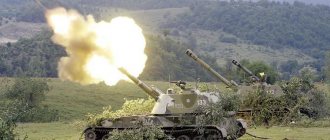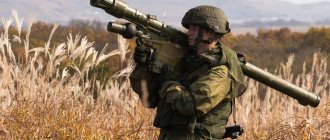Restricted zones
The US Armed Forces are purposefully working to modernize and increase the combat capabilities of their artillery. The goal is to equalize the current advantage of Russia and China in this area. Modern Russian cannon and rocket artillery is capable of firing 1.5-2 times further than comparable American weapons. However, according to Western experts, there is an even more compelling reason for modernizing US artillery.
Both Russia and China are purposefully creating operational formations consisting of modern fighters, long-range air defense systems, ballistic and cruise missiles, as well as electronic warfare and command and control systems. These combinations of offensive and defensive systems make it possible to keep American ships and aircraft at a distance preventing attacks on their troops or their own territory ( Anti-Access/Area Denial - A2/AD
, russian
- restricted access zone). Dong Feng
21D ballistic missile , designed to destroy aircraft carriers at a range of up to 1,500 km, attracts much attention from Western experts in this regard.
PLA ballistic missile "Dong Feng 21D"
Russian air defense systems
However, the greatest concern is about modern Russian air defense systems, which can limit the operational capabilities of American forces.
John GORDON
So, according to John GORDON, an expert on weapons research (RAND Corporation),
the range and lethality (...) of any form of air support will be complicated (...) ground forces will feel the consequences.
A study conducted by the Rand Corporation on behalf of the US Armed Forces showed that Russia would have gained a significant tactical advantage during the first ten days of a war in Eastern Europe. Internal estimates of the US Army even proceed from the fact that “within several weeks” the use of aviation (stealth fighters) in the front line or behind the front line will be possible only to a limited extent.
At the same time, the area of influence of “forbidden zones” (A2/AD systems) extends far beyond its own borders. In particular, the S-400 anti-aircraft batteries stationed in Kaliningrad with a range of up to 400 km allow Russia to cover about a third of Polish airspace and the entire Baltic Sea. De facto, they are capable of creating a exclusion zone for conventional NATO aircraft. Crimea is similarly fortified, complicating access to the Black Sea. The S-500 system under development, according to Western knowledge, reaches a range of about 600 km and, through interaction with satellites, is presumably also capable of capturing stealth aircraft.
S-500 "Prometheus" air defense system
Air Force
One of the most famous American projects in this field is the Air Launched Rapid Response Weapon, or ARRW (the system was also designated AGM-183A).
We are talking about an extremely interesting and even revolutionary development in many respects. Experts believe that the ARRW is a solid-propellant aeroballistic missile equipped with a detachable hypersonic warhead powered by a Tactical Boost Glide engine. The hypersonic unit, according to some data, is capable of reaching speeds of more than Mach 20. The warhead can be of several types, including nuclear.
AGM-183A Air Launched Rapid Response Weapon / ©lenta.ru
AGM-183A / ©ruposters.ru
We could see the AGM-183A last summer: then the US Department of Defense showed June tests involving a mock-up of the complex suspended under a B-52 strategic bomber.
The Russian-language media greeted the American development with traditional coolness. “We are talking, apparently, about creating an analogue of our “Dagger” based on the X-51 Waverider. The rocket was tested several years ago, and then the developers were faced with the fact that the engine failed too early - probably when the rocket entered denser layers of the atmosphere. If this problem is not solved, then development will not move forward,” said military observer Mikhail Timoshenko.
To be fair, domestic experts are lying. There was no talk of any analogue of the “Dagger”: except that the AGM-183A ballistic missile, which acts as the carrier of a hypersonic unit, is vaguely reminiscent of a Russian product. De facto, “Dagger” and ARRW are fundamentally different systems. Moreover, apparently, neither Russia nor China has a direct analogue of the Air Launched Rapid Response Weapon. The ARRW is scheduled to achieve initial operational capability by 2022.
US artillery replaces and complements air support
According to the views of the US Army command, US long-range artillery in modern conditions receives a different purpose. At the initial stage of the war, its most important task is to destroy the infrastructure of A2/AD zones in order to create gaps for tactical aviation. Other important tasks will be supporting forward units, as well as delaying enemy deployment.
Forbidden zones of Russia in the European theater of operations
In the European theater, to avoid a pre-emptive strike in advance of a conflict, ground artillery may be dispersed. In Asia, army artillery, together with marines, is expected to be deployed on the islands of the archipelago and attack Chinese missile and anti-aircraft units from dispersed positions.
U.S. artillery, whenever possible, should be used in conjunction with air- and sea-launched remote weapons that fire from positions beyond enemy range. The use of the most diverse means of destruction, approaching from different directions, is believed to lead to overloading the enemy’s defensive systems. After the military infrastructure of the A2/AD zones has been sufficiently weakened, it will be possible to use US or allied aircraft in the front line and over enemy territory.
Long range precision fire
US artillery is being modernized under a program called Long-Range Precision Fires (LRPF
). General Mark MILLEY, Chief of Staff of the US Army, gives this project the highest priority among various military modernization programs.
General Mark MILLEY
The long-range precision weapons being developed under the program are classified into three operational categories based on the scale of their impact.
Tactical Fires Systems
) It is planned to develop a 155 mm howitzer with a firing range of up to 70 (later 100) km. According to publications, such a doubling of the firing range will be possible thanks to the lengthening of the gun barrel and the emergence of new ammunition that uses reactive propulsion principles. At the same time, rocket shots must reach hypersonic speed.
According to LRPF program manager Brigadier General Steve MARIANAN, testing is expected to begin within “several years.”
Operational Fires
) It is planned to replace the ATACMS tactical missile system (range 300 km) with a new high-precision missile system PSM (
Precision Strike Missile
) with a launch range of 499 km.
Promising PSM complex
It is especially emphasized that the indicated upper range limit is a conscious signal from the United States, which wishes to preserve the Intermediate-Range Nuclear Forces Treaty (hereinafter referred to as the INF Treaty) of 1987. The bilateral US-Russian agreement prohibits the production and deployment of ballistic missiles (nuclear and conventional) with a range of 500 to 5000 km. At the same time, the US Army states: from a technical point of view, a new high-precision missile could reach a greater range.
The new missile is half the size of the previous ones, so transport platforms from HIMARS or MLRS will be able to double the amount of ammunition carried. Prototype testing from ( Lockheed Martin
) and Raytheon
will take place in 2019-2020 . The possibility of operational use of the first samples is expected from 2023. Achieving full operational readiness is scheduled for 2027.
Concept sketch of the PSM rocket
It is assumed that the PSM installation will primarily be used to destroy stationary ground targets: enemy deployment centers, temporary airfields and rear depots. According to a statement by General S. Marian, later, thanks to improvements, the missile will make it possible to hit mobile ground and sea targets. The latter ability is desirable primarily for missions in the island-rich areas of the Western Pacific. Once equipped with submunitions, the PSM's capabilities will ensure the destruction of battle tanks and self-propelled artillery.
Strategic systems ( Strategic Fires
) The purpose of “strategic” artillery is to destroy targets at a range of up to 1800 km. It is this category of American artillery that should provide the key to overcoming the enemy’s A2/AD zones.
The scandalous story of Lego Glock
Last summer, a scandal broke out in America around the Block19 pistol, stylized as a Lego constructor. In June 2022, Culper Precision, a company that produces custom small arms, released a pistol in an original design to the market. It was the well-known Glock, but as if assembled from Lego parts. The result was a cheerful “toy” in red, yellow and blue colors, which was offered at an affordable price of $549–765. In an Instagram post, Culper Precision explained that the Lego Glock was designed to evoke the joy people get from the shooting sport.
Culper Precision Block19 Pistol
Culper Precision
Local hoplophobes immediately took up arms against the new product, saying that children could easily mistake Block19 for a real toy, and then trouble would follow. In general, a weapon that resembles a toy is bad. United States laws prohibit the production of children's toys that look like real guns, but there is no prohibition on the production of guns stylized as toys. Therefore, Culper Precision responded that everyone has the right to tune and customize their weapons as they wish, within the limits of the law.
But Lego itself got involved in the matter, which is extremely jealous of any attempts to copy its products. And here the concern also saw a threat to its reputation, because God forbid an accident actually happens!
As a result, Culper Precision did not decide to enter into a legal battle with the famous toy manufacturer. After receiving the complaint from Lego, the company removed all information about Block19 from the site and pledged not to release it again.
US "strategic" artillery beyond long range
According to Western experts, the strategic component represents the greatest technological challenge within the LRPF program. Accordingly, its status is least defined: details are still being developed.
Determined: US strategic artillery should consist of two different weapon systems. Speaking to the House of Representatives on September 13, 2022, the head of the US Army Futures
) General John MURRAY stated:
We are starting with the development of hypersonic missiles and aiming to develop barreled guns with a potential launch (firing) range of up to 1000 nautical miles
.
The stated range of 1,850 km - if it can be realized - is 10 percent greater than the launch range of the Tomahawk sea-launched cruise missile
). Such capabilities would make it possible to strike deep in enemy territory.
General John MURRAY
Hypersonic missiles
As noted, mobile hypersonic missiles must have a minimum speed of MAX 5 and hit fortified targets. Obviously, the arsenal of these weapons will be limited. Consequently, only particularly important targets will be assigned for its use - primarily control bunkers, radar positions and air defense networks.
According to publications, the ascent phase and the middle phase of the missile trajectory will take place in ballistic flight. In order to overcome the air defense/missile defense system, the gliding phase is seen as very maneuverable, like that of an airplane. Destruction of the target could be achieved without the use of a warhead, only thanks to the kinetic energy of the impact.
The hypersonic missile is being developed as an interspecies project. Each branch of the US Armed Forces optimizes weapons based on the characteristics of their operational use. In particular, the US Army command wants to achieve a flight range of up to 2600 km.
US air-launched hypersonic missile
Barrel artillery
The US strategic barrel artillery within the framework of the program received the designation “strategic long-range weapon” ( Strategic Long-Range Cannon, SLRC
). The desired range is defined as “only” 500 km. Such a weapon should fire projectiles with a built-in rocket engine and be used against weakly protected targets. Preferred targets are radars, mobile command posts, airfields, positions of anti-aircraft missiles and enemy missile and artillery batteries.
As Secretary of the Army Mark ESPER summarized:
If I can weaken the enemy's air defense system - be it guns, missiles or radars - this will clear the way for aviation. Using our artillery with a range of several hundred miles, we could suppress enemy defenses from the coast and provide access to closed waters for American ships and submarines.
As with hypersonic missiles, several stages of flight are provided for missiles launched from a gun. The initial ballistic phase and the sliding phase unfolded in space.
155 mm howitzer M109A6 “Paladin”
According to the plan, the system should be exclusively mobile. At the same time, to achieve the desired range in terms of caliber, barrel length and weight, the gun must be significantly larger than a modern 155 mm howitzer. Therefore, US Army specialists are moving away from the term “mobile” and talking about “transferable” weapons. In special US military periodicals, there are suggestions that to make it more difficult to target enemy missiles, the gun will be able to move along railway tracks inside a closed zone protected by air defense systems.
Why didn't the Germans adopt the Arab machine gun?
In Germany, there was a scandal with the choice of a new machine gun for the army. In March 2022, the country's Ministry of Defense issued a release announcing that CG Haenel had dropped out of the tender to replace the G36 assault rifle/machine gun, which has been in service since the mid-1990s. Although six months earlier, it was the CG Haenel sample called MK556 that won the competition, and its purchases were supposed to begin before the end of 2022.
The intrigue was that the winning company is in fact Arab, because it belongs to the Caracal International LLC concern from Abu Dhabi. And besides, the structure and design of the MK556 was very similar to the popular NK614 automatic carbine from Heckler & Koch, which also participated in the competition. In both samples, the American AR15/M16 was taken as a basis, in which the direct gas outlet (powder gases from the barrel through a thin tube are discharged into the bolt frame) was replaced by a gas piston with a short stroke - it was Heckler & Koch that first proposed such a solution.
Assault rifle MK556 CG Haenel
C. G. Haenel
Heckler has been a permanent supplier of the Bundeswehr for many years - its NK G3 automatic rifle was in service since 1959, until it was replaced by the NK G36. For this competition, the company presented two samples at once: the mentioned NK416 and NK433, and suddenly there was such an embarrassment. It was clear that Heckler & Koch would not want to give up the contract for 245 million euros without a fight. And so it happened: his lawyers accused CG Haenel of violating a 2007 patent, which included solutions to allow the weapon to be safely fired after immersing the weapon in water. Six months later, Bundeswehr experts came to the conclusion: yes, the patent was violated.
However, the elimination of CG Haenel from the competition did not automatically make Heckler&Koch the winner. The process of selecting a new machine gun froze, and the Ministry of Defense suddenly issued a statement that the current G36 is “a weapon that soldiers completely trust.”
“It doesn’t matter how the competition ends, it will be a replacement of sewing with soap,” weapons historian Maxim Popenker commented on the situation. – This is a weapon chambered for one 5.56x45 cartridge. From the point of view of the unit’s fire capabilities, nothing will change at all.”
Implications for arms control
According to publications, the US Department of Defense proceeds from the fact that both strategic weapons, despite their range, comply with the requirements of the INF Treaty. As justification, a description of the flight of the specified weapon is given.
The three-decade-old treaty details the banned missiles. The text of the treaty specifically refers to ballistic and cruise missiles that are used from the ground. The text of the treaty defines both categories of weapons according to their behavior in flight:
The term "ballistic missile" refers to a missile that follows a ballistic trajectory for the majority of its flight... The term "cruise missile" refers to an unmanned, self-propelled missile that is supported for most of its flight by aerodynamic lift
(INF Treaty, § II, paragraphs 1-2).
If a weapon under development—as currently envisioned—exhibits variable flight behavior, it should not fall into a prohibited category under the INF Treaty, Pentagon legal experts argue.
The West expects that, regardless of the subtleties of the treaty text, Moscow will consider the appearance of rocket artillery with a range of 1,000 miles as a violation of the INF agreement. In particular, Russia is already pointing to the deployment of missile defense facilities in Poland and Romania as a violation of the INF Treaty. VLS) designed to accommodate interceptor missiles
) also for the use of Tomahawk cruise missiles.
It is noted that Russia will raise this topic in order to distract from its own violation of the INF Treaty after adopting the 9M729 medium-range missile. Moscow could use strategic fire systems as a pretext to denounce the INF Treaty. According to the West, the Russian leadership hopes to be able to build up its existing advantage in the field of medium-range missiles in an open arms race.
9M729 rocket launcher
US position
At the same time, there are voices in Washington also in favor of ending the INF Treaty. The 2022 military budget adopted by the US Congress in September 2022 contains non-binding recommendations to temporarily suspend the INF Treaty and begin developing new intermediate-range weapons. Three arguments are given:
- Since Russia is already violating the treaty anyway, compliance is a strategic disadvantage for the United States. To counter the threat, it would be better to develop new weapons without restrictions.
- Even if Russia adheres to the treaty, the INF Treaty causes strategic damage to the United States, since Beijing is not a party to the agreement and possesses significant quantities of intermediate-range weapons.
- For purely operational reasons, it makes no sense to abandon measures that promise success to neutralize the advantages of the A2/AD zones of potential adversaries. The prospect that one of the two parties to the INF Treaty will withdraw from it before strategic weapons are developed is still great.
Thus, publications in the European military press prove only one thing: the US withdrawal from the INF Treaty was justified and prepared long before the demarches of the American administration at the end of this year.
Based on materials from the magazine “Europäische Sicherheit & Technik”
The Pentagon did not fulfill its promise to purchase the latest small arms
The grandiose American program for the development and implementation of new generation small arms NGSW (Next Generation Squad Weapons) has stalled. In 2022, the US military department promised to purchase a pilot batch of approximately 4 thousand pre-production NGSW samples, and a year later to begin their mass production. But that did not happen. Moreover, information appears that the program can be radically reformatted.
The NGSW project involves the development of a new 6.8 mm caliber cartridge, assault rifles and machine guns for it. The new weapon should immediately replace in the army automatic M4 carbines chambered for 5.56x45, as well as rifles and machine guns chambered for 7.62x51 mm. But the characteristics of the promising ammunition initially raised many questions. Thus, a bullet weighing about 9 grams has an initial speed of up to 945 m/s. Thus, its muzzle energy exceeds 4000 J.
For comparison: a 7.62x51 mm rifle cartridge bullet has an energy of approximately 3060–3070 J, and the military refused to use it in hand-held automatic weapons, since it was almost impossible to conduct targeted burst fire due to high recoil. And here the energy, and therefore the recoil impulse, is even higher. In addition, with such characteristics, very rapid barrel wear is inevitable.
Miracle bullet: why the United States is starting a new war of machine gun calibers
In 2022, three companies presented their models of assault rifles and machine guns: SIG Sauer, General Dynamics and Textron Systems. It was assumed that, based on the results of comprehensive tests, the Pentagon would select the best sample and order a test batch. But things didn't go according to plan. First, General Dynamics changed ownership, coming under the control of True Velocity, and then dropped out of the competition altogether. Her weapon had a bullpup layout (the fire control handle is located in front of the magazine and the breech of the barrel), which the American military does not like. The next participant, Textron Systems, left the competition himself, without explanation. There is only one SIG Sauer left, but its prospects are vague.
Thus, a participant in the Military Guns and Ammunition forum, citing an industry source, reported that generals are allegedly changing their attitude towards the 6.8 mm caliber and are looking for a new compromise between high power and the possibility of comfortable shooting. In particular, ammunition options in calibers of 6 mm, 6.35 mm and 6.5 mm are being considered. “It’s clear that these are just rumors, but I wouldn’t be at all surprised if the truth turns out to be close to them,” said weapons historian Maxim Popenker.
Just watch demonstration videos of shooting from experimental weapons in 6.8 mm caliber. Thus, in a video with a SIG Sauer assault rifle with a shortened barrel, it can be seen that the shooter experiences recoil even stronger than when shooting with a rifle cartridge. Not only effective automatic fire, but also rapid single fire is hardly possible here.











